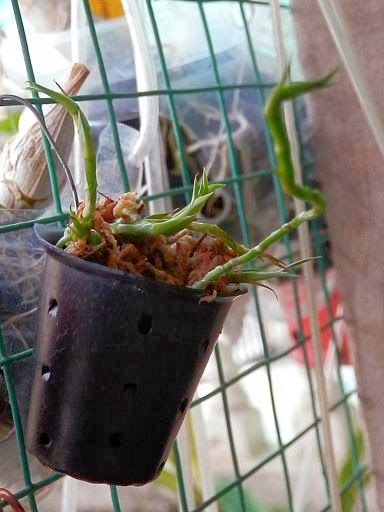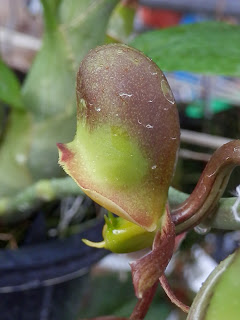this post is meant for those who are interested to do home flasking, with commercial media available nowadays, home flasking is feasible. all you need is some reading up and some creativity to do your own sterile chamber. there are many different recommendations but what i am presenting here is the methods that suits me best.
just got this medium today, medium P668, according to the website it is suitable for most epiphytic and some terrestrials orchids.most important, it is stated there " no pH adjustment needed". just what i need as i do not had a pH meter. this is my first try on a commercial media. it's black in color, if i am not mistaken it contains charcoal inside.
there are still a couple of other mediums suitable for catasetums but i am just using this P668 because this is what was suggested to me by senior growers.
close up on the packet label =D
a good example of a bad example, i guess i was too hard in scrapping the green pods, a chunk of the seed with the pulp fell inside. my view was obscured with the vapor building up in the small aquarium tank, basically almost all of the flask had a chunk of seeds in it.
sometimes when greed pods are not available or when the pods had already started to crack because it had already mature, then the seeds needs to be sterilized before flasking.
i used this method i read from internet, using a clean sterile tube, required amount of seed is put in the tube with small amount of table sugar. a few ml of water is added and then a very minute drop of detergent before closing the tube. then the tube is agitated and then left to stand for the next 24 hours.during this period, the tube is gently shake every 6 hours. by the end of the period, the seeds would already sink to the bottom of the tube.
after that the seeds are sterilized with 1:20 dilution of household bleach for 10 minutes and then rinse 2-3 times before sowing.
for those who are curious how orchids seeds are like, here is a pic of them, MAGNIFIED!
after flasking, i usually check them over the first week period to look for any evidence of contamination (usually characterized by presence of fluffy white stuff or formation of white/opaque plaque like structure on top of the agar). contaminated flask are usually discarded. after that, it is just waiting time for those green little gremlins to pop out.
initial appearance of germination, some of the protocorn are turning green but not clearly visible because of the lighting.
5/9/13
from the mother flask to replatting
the fleet of armada
protocorns at two months plus (the picture is blur because the super macro mode of my digital camera cannot get a good focus due to the reflective surfaces of the glass bottle )
these protocorns are after replatting, i am putting less protocorns into each replating flask to avoid the need for future replating, this is to reduce chances of contamination.
the pic below show the emergence of the first shoot from the protocorns, these shoots will eventually grow leaves and eventually roots will form from the base.
the pics in this thread will be updated from time to time to show the development of these protocorns till they are ready to be deflask. i may post a post about deflasking in the future.
10/10/2013
7/2/2014
deflasked keiki, the first one is experimental unit without replating, somehow no prominent leaves is formed.
the two pics below is deflasked from replated flask. the last pic shows yellowing of some of the leaves due to the drastic change of the microenvironment to the harsh environment. mixture of sphagnum and charcoma media is used here


















































